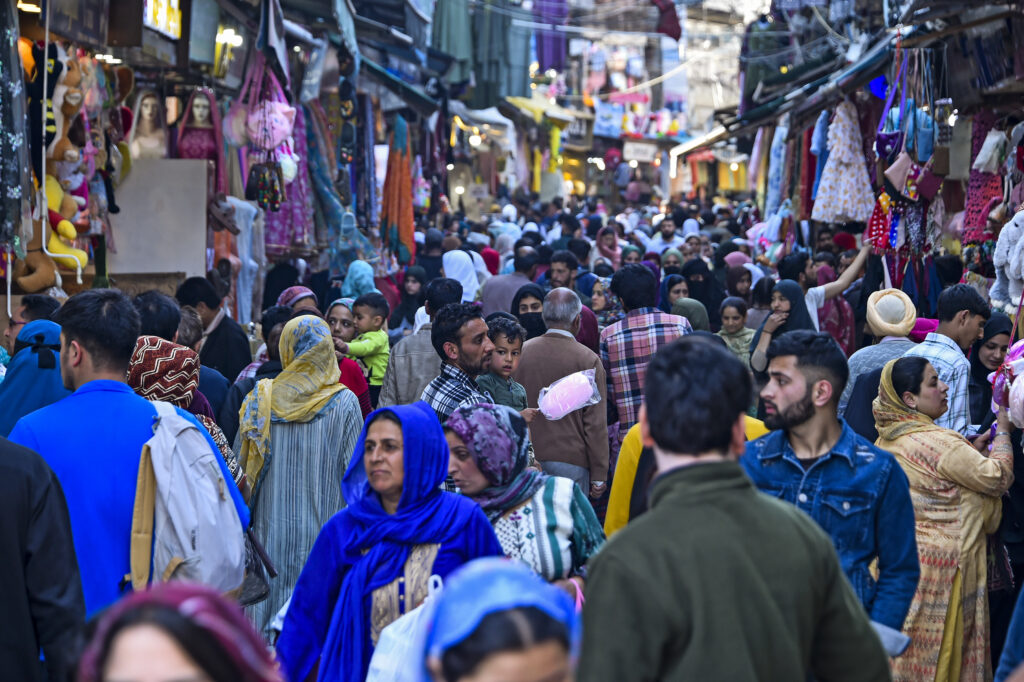Eid Without Joy: Kashmir’s Festivals Dampen Under Economic Despair
Srinagar 04 May 2025: This year’s Eid in Kashmir tells a somber story. Where streets once overflowed with joy and markets buzzed with eager shoppers, silence and subdued activity now dominate. Eid—traditionally a time of generosity, gifting, and celebration—has been overshadowed by the stark reality of an economic crisis that has affected thousands of households and local businesses.
Why This Eid Feels Different
In bustling areas like Lal Chowk and Residency Road, footfall has drastically declined. Traders selling festive attire, bakery goods, and traditional wares report a 60–80% fall in sales. For many vendors, this Eid has brought losses rather than prosperity.
Unpacking the Crisis: Key Drivers Behind the Economic Downturn
01. Liquidity Crunch Among Traders
Local businesses across Kashmir are experiencing a crippling liquidity crisis. With delayed government payments, poor consumer turnout, and low working capital, many traders are unable to restock or run operations effectively. Traditional Eid shopping, usually a peak revenue period, has instead seen empty shops and idle staff.
02. Inflation and Mounting Debt Burdens
Rising prices for essential commodities—from food to clothing—have pushed Eid expenses out of reach for many families. Additionally, debt burdens from previous losses due to lockdowns or political uncertainty are crushing small businesses and households.
03. Tourism Disruption After April 22 Pahalgam Attack
Kashmir’s economy heavily depends on tourism. The April 22 attack in Pahalgam led to widespread cancellations of bookings, affecting hotels, tour guides, transporters, and artisans. With fewer tourists, income streams have dried up, aggravating the broader economic woes.
04. Shrinking Household Budgets
Kashmiri families are now focused on survival. Wages have stagnated or disappeared entirely. Government employees face delayed salaries, and daily-wage earners are barely scraping by. With limited disposable income, the cultural and commercial spirit of Eid has dampened significantly.
Fallout for Local Businesses
60-80% Drop in Sales
Retailers, especially those dealing in traditional Eid items like pherans, dry fruits, embroidered garments, and bakery goods, have reported massive losses. Many had invested heavily in seasonal stock expecting festive demand, only to be met with silence.
Reduced Footfall
Once-thriving markets are witnessing minimal activity. Streets that typically host night markets are closing early. Business owners say this is the slowest Eid season in over a decade.
Vendors on the Brink
From the saffron sellers of Pampore to the copperware artisans of downtown Srinagar, many are contemplating closing shop. With expenses exceeding earnings, financial sustainability is at risk.
What Lies Ahead? Expert Recommendations
Economists and policy analysts have issued an urgent call for economic revival in Kashmir. The need for immediate government intervention, coupled with long-term development policies, is more pressing than ever.
Proposed Economic Recovery Strategies
Tourism Revival Initiatives
- Launch national and international tourism campaigns
- Strengthen safety protocols and publicize secure travel zones
- Promote local festivals, arts, and winter sports to increase seasonal engagement
Financial Relief for Small Businesses
- Implement interest-free loans and EMI moratoriums
- Provide tax relief for sectors hit hardest by the downturn
- Release pending government payments to vendors and contractors
Boost to Local Industries
- Encourage manufacturing hubs for handlooms, saffron, horticulture, and handicrafts
- Upgrade local industrial infrastructure in collaboration with FCIK and KCCI
- Support public-private partnerships for innovation and scaling
Comprehensive Employment Programs
- Establish vocational training and certification centers
- Focus on skill development in tourism, IT, healthcare, and construction
- Launch rural employment schemes aligned with infrastructure projects
Reviving the Valley’s Economic Engine: A Strategic Roadmap
01. Rebuilding Tourism – The Backbone of Kashmir’s Economy
Tourism directly supports thousands of livelihoods. Strategies include:
- Partnering with influencers and digital creators to change perception
- Offering travel insurance and secure tourist routes
- Developing niche travel circuits: religious tourism, wellness retreats, snow sports
02. Empowering SMEs and Artisans
- Financial subsidies for Kashmiri craft and textile industries
- Introducing digital tools and training for online sales
- Organizing trade expos and buyer-seller meets within India and abroad
03. Creating Jobs Across Sectors
- Encourage start-ups through incubation centers and grants
- Expand cold-chain facilities for horticulture export
- Incentivize IT firms to set up development centers in Srinagar and Jammu
04. Delivering Financial Relief & Social Safety Nets
- Direct Benefit Transfers (DBTs) for economically weaker families
- Waivers on electricity and water bills for struggling sectors
- Encourage diaspora investment through structured NRI channels
Bottom-Line: Restoring Joy to Future Eids
Kashmir’s current economic condition is a critical juncture—not just for business, but for the soul of the Valley. Eid without celebration is not merely a financial concern; it’s a symbol of deeper socio-economic distress.
Immediate intervention, thoughtful policy, and inclusive recovery programs are essential to uplift the Valley from its current hardship. Kashmir doesn’t just need financial aid—it needs hope, jobs, tourists, investment, and the opportunity to heal.


